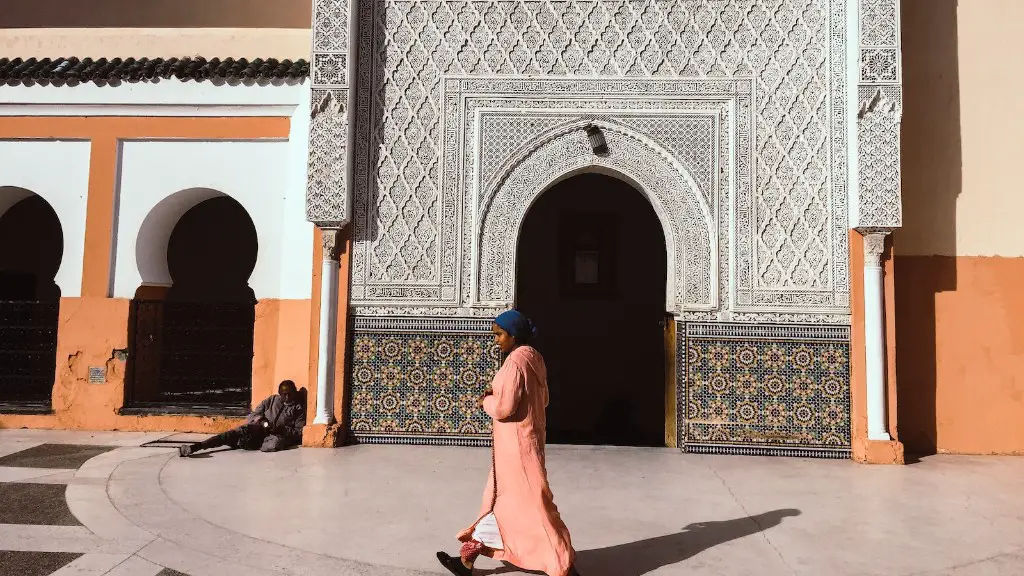How Did Hinduism Influence Social Structures In India
Hinduism is the oldest of the major religions of India, with roots going back to the ancient Vedic tradition. It has played a central role in India’s cultural and religious life for centuries, influencing the development of its society and shaping its values, beliefs, and codes of behavior governing everyday life. Hinduism is not considered a single religion but rather encompasses a wide variety of related beliefs, practices, and ways of life.
The Hindus of India developed a complex and rigid hierarchical structure, with different castes or social classes that governed marriage, diet, clothing, jobs, and other aspects of life. This system became known as the caste system, or varnaashrama, and it was based on the Hindu principle of karmic reincarnation, which dictates that a person is born into a particular caste based on the work they had done in previous lives. According to this idea, those belonging to the highest “Brahmin” caste were said to have lived good lives in previous incarnations, while those belonging to the lower castes had done something wrong to deserve their lesser station.
In the early years of the caste system in India, those belonging to the upper castes had the majority of the power, privilege, and wealth. Most political power resided with the Brahmin clergy and the Kshatriyas, the second-highest caste, while other castes like the Vaishyas, Shudras, and Dalits (Untouchables) occupied the bottom of the social hierarchy. This system of power and privilege was not just a product of religion, but was also tied to economic, political, and social factors.
Hinduism has also influenced the way in which Indian society has evolved over the centuries. Through the teachings of karma and reincarnation, Hinduism has contributed to a focus on group rather than individual identities, so that the needs of the group are seen to be more important than the needs of individuals. This emphasis on group identities has been one of the reasons why Indian society has remained so hierarchical and hierarchical structures remain very much a part of Indian social life today.
Hinduism has also played an important role in the development of India’s education and health care systems. Education and healthcare were traditionally the domain of the Brahmin priestly class, who taught and served the needs of those from the highest castes. Over the centuries, however, education and healthcare slowly began to be made available to the lower castes, albeit on a smaller scale than the privileged few.
Hinduism has also played a crucial role in influencing gender roles in Indian society. The traditional role of women has been a domestic one, with men being responsible for most outside activities. This idea has been strongly influenced by the beliefs of Hinduism, as many of the stories and teachings in the Hindu scriptures focus on the subjugation of women. In modern India, while the gender roles have become far more flexible than before, the traditional values still remain a major factor in the way that women are viewed and treated.
Hinduism has had, and continues to have, a profound effect on social structures and gender roles in India. The complex caste system, the emphasis on group identities, and the traditional roles for men and women have all been shaped by the beliefs and teachings of Hinduism over the course of centuries of Indian history.
The Role of Hinduism in Art, Music, and Literature
Hinduism has also had a strong impact on Indian art, music and literature. Hindu gods, goddesses and stories have been a major part of the inspiration for art and music since ancient times. Art has always been a powerful medium to tell stories that reflect the beliefs of Hinduism, which has in turn shaped and defined the Indian culture.
In Hinduism, art and music were traditionally linked with religious ceremonies and rituals for celebrations of all kinds. In temples and in daily life, the use of art was prevalent in both religious and social contexts. This has influenced the art forms such as painting, sculptures, music, and literature, which now draw heavily on Hindu themes and symbols.
In modern India, Hinduism still has an influence in the way art, music and literature are created, though it is far less pervasive than it was in the past. Hindu ideas, particularly the belief in karma and reincarnation, have been incorporated into the work of many Indian artists, musicians, and writers to create a unique cultural identity and aesthetic.
The Hindu gods are also frequently seen in Indian literature, music, and movies. This is largely because of the way these gods are used as symbols of divine power, of virtues and values, and as metaphors that can be interpreted to reflect the beliefs and values of particular cultural contexts. As such, Hinduism has been an important part of the cultural life of India, both historically and in the present day.
The Relationship between Hinduism and Other Religions
Hinduism has also influenced other religions in India. One of the earliest examples is Buddhism, which was founded by the Indian prince Siddhartha Gautama in the 6th century BCE. While Buddhism initially rejected many of the traditional beliefs from Hinduism, it would eventually come to be one of the major religions in India, alongside Hinduism, Jainism, and Sikhism.
The influence of Hinduism on other religions has been both direct and indirect. One example of a direct influence can be seen in the shared belief in karma and reincarnation, which is a cornerstone of Hinduism, Buddhism, Jainism, and Sikhism. On the other hand, some religions have adopted certain aspects of Hinduism while rejecting others, such as Sikhism’s emphasis on the importance of work and duty, which is derived from Hinduism.
Moreover, many of India’s other beliefs and traditions, such as tantra or yoga, are rooted in Hinduism. In some cases, aspects of Hinduism have also been adopted by other religions outside of India, such as Buddhism in Japan, as well as in some New Age spiritual practices around the world.
Hinduism has had a long and complicated relationship with other religions, both in its native India and abroad. It has influenced other religions in various ways, while at the same time evolving and adapting in accordance with the changing times.
The Effect of Hinduism on Indian Politics
Hinduism has also had an effect on Indian politics. Hinduism is seen as a unifying force in India, and the government has at times drawn upon its teachings for political gain. For example, Hindu nationalist groups such as the Bhartiya Janata Party have used symbols and beliefs from Hinduism to promote their very particular views of Indian nationalism.
This has caused tension between Hindu and non-Hindu groups in India, particularly between Hindus and Muslims. The promotion of Hindu nationalist ideas has led to an increase in communal violence between these two groups in recent years. On the other hand, Hinduism has also been the source of some positive developments in Indian politics, such as the promotion of greater religious tolerance and an embrace of diversity.
Hinduism has also played an important role in the development of India’s political institutions. Its teachings on social justice have been used to justify India’s constitutional and legal systems, while also providing a moral and spiritual basis for the nation’s democracy.
Hinduism has had a long and complex history with Indian politics, both influencing and being influenced by it. While Hindu nationalist groups have sought to use it to further their political goals, Hinduism has also been a source of inspiration and guidance to the nation as a whole.
The Impact of Hinduism on Modern Indian Society
Hinduism has had an immense and lasting influence on Indian society. Its value system and beliefs are embedded within the culture, and its teachings and stories still shape the way people think, behave, and interact with one another today.
Hinduism has contributed to modern Indian society in a number of ways, from its focus on personal responsibility and growth, to its views on the importance of relationships and family. It has also provided a moral and spiritual foundation for the nation’s democratic institutions, encouraging respect for the rule of law.
At the same time, Hinduism has also been the source of some of the issues that India faces today, such as the gender gap and the persistence of the caste system. However, it is important to remember that these problems are not exclusively the result of Hinduism, and it would be unfair to blame a religion that has existed for centuries for the many social ills that plague India today.
Hinduism has had an incredibly wide-reaching influence on modern Indian society, and its teachings and values remain at the heart of the nation’s culture. Whether for good or bad, it is clear that Hinduism will continue to shape the social structures, beliefs, and values of India for many years to come.

